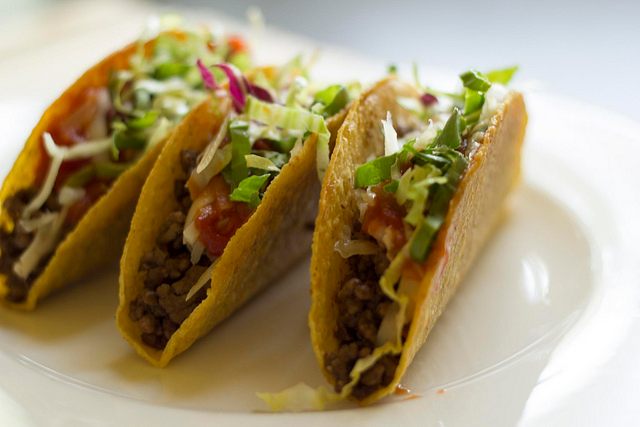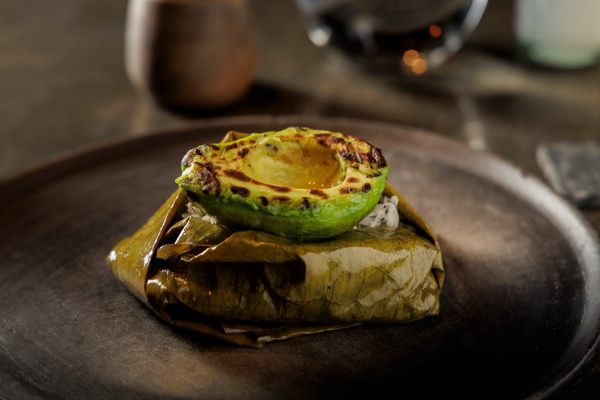The Texan Who Invented Chili Powder Also Accidentally Created the American Taco

An American hard shell taco. (Photo: Luca Nebuloni/flickr)
For many Americans, a taco looks like this: a U-shaped deep-fried corn tortilla shell filled with seasoned ground beef, shredded iceberg lettuce, cheddar cheese, and maybe salsa or chopped tomatoes. It’s emoji-level recognizable, an ’80s and ’90s childhood staple. But the taco’s detractors have been taking aim in recent times. “A few years back, like watching a favorite childhood movie and noticing how terrible it really is, I finally realized that hard taco shells are a sham,” wrote Serious Eats food writer J. Kenji López-Alt in a 2011 post reminiscing about the less-than-stellar taco nights of his childhood. Anthony Bourdain has repeatedly lashed out at Taco Bell and Tex-Mex for sullying the true Mexican taco with dirty American ingredients.
Like General Tso’s chicken or a meatball parm sandwich, it seems logical that the American taco has no real relationship to its original culture. A carnitas taco served on a paper plate in Mexico City—that’s authentic. A ground beef taco served by a Taco Bell in Indianapolis, well, that’s something else. Something worse.

But where did the American taco really come from? And what does it say about us?
First of all, it’s a mistake to believe that the iconic hard shell taco is something that clueless white people invented. “Both Americans and Mexicans would love to believe that the hard-shell taco was a travesty of an invention by clueless gabachos. But that’s simply not the case,” says Gustavo Arellano, perhaps America’s foremost scholar on the taco. Arellano is the writer behind the advice column “Ask A Mexican,” the author of Taco USA: How Mexican Food Conquered America, and also the editor of the OC Weekly newspaper in his native Orange County, California.
“Mexicans have been eating what we now call tacos since time immemorial,” says Arellano. “The idea of stuffing something into a tortilla—we’ve been doing that since there were tortillas, so we’re talking thousands of years ago.” But Mexican cuisine is incredibly regional, being almost as varied in climate and geography as the U.S., from deserts in the north to the tropics in the south, the Sierra Madre mountain range in the west to central valleys. And Mexican cuisine is a product of varied influences the same way American cuisine is; the many different Indian populations; the Spanish conquest; waves of immigrants from North, South, and (especially recently) Central America; French, German, and Jewish immigrants from Europe during World War II; Lebanese and other Arab immigrants who brought meat-on-a-spit traditions.
All of these blended together and were filtered through the ingredients that people had at hand. There are old ways of doing things, and newer ways. But they’re all Mexican, and for Arellano, “good” and “bad” are largely unrelated to “old” and “new.” The term “authentic” is entirely meaningless.

Taco shells. (Photo: Helen Penjam/flickr)
Tacos, says Arellano, were until the 1800s generally more popular in central and southern Mexico, where more common fillings would be pork, chicken, seafood, or vegetables. But the taco’s popularity increased in the 19th century in the north, and northern Mexicans had a different meat of choice. “All of northern Mexico is beef country,” says Arellano. “Sonora, Baja California, Nuevo Leon, Chihuahua, that’s where beef is king.” That was as true north of the border as south. “Putting a whole bunch of ground beef on a flour tortilla is a cowboy tradition,” says Robb Walsh, a Galveston-based food writer and authority on all things Texas, from barbecue to Tex-Mex. (He also, coincidentally, went to the same elementary school as Arellano before moving back to Texas.)
There are a few different types of beef tacos; carne asada, grilled hunks of beef, is most common, but lengua, tongue, along with a few other offal cuts especially from around the cow’s head are also easy to find. Ground beef, though, of the type you’d find in Taco Bell? That would be most recognizable in northern Mexico as picadillo.
Picadillo is a dish consisting primarily of minced or ground meat and is found in pretty much every country Spain ever had a hand in, from Mexico to Cuba to the Philippines. It varies from country to country and region to region; in Caribbean cuisines, especially Cuban, Dominican, and Puerto Rican, it’s often cooked with raisins and olives and served with rice. In Mexico it varies in form, sometimes served as a soup, sometimes cooked with less liquid with potatoes (sort of like a hash), and sometimes even drier and less saucy and served in a taco.
Crispy tacos, too, exist perfectly authentically, whatever that means, in Mexico, and have for quite a long time. Sometimes they’re called tacos dorados, or golden tacos, and if the taco is first rolled into a cigar shape before frying can be called a taquito or sometimes a flauta, depending on size or just local terminology. “They’re often made with potatoes and eaten during lent,” says Arellano. The main differences between tacos dorados and a Taco Bell taco is that the filling may be slightly different, and will be fried to order (and sometimes fried whole) rather than placed in a pre-fried shell. But really, they’re not all that different.

Fajitias in a packet: Old El Paso mix on sale. (Photo: Quinn Dombrowski/flickr)
In 1914, the recipe widely cited as the earliest known recipe for tacos was published, by Bertha Haffner-Ginger in a book called California Mexican-Spanish Cookbook. Her recipe describes the taco as follows:
“Made by putting chopped cooked beef and chile sauce in tortilla made of meal and flour; folded, edges sealed together with egg; fried in deep fat, chile sauce served over it.”
This would not easily recognizable as a taco today; I think most would identify this dish as an empanada. But the parts are all there, setting the stage for Old El Paso and Taco Bell.
The story of most American adaptation of new dishes in the 19th and 20th centuries relies on two processes: preservation and mass production.
In the late 19th century, the Mexican-influenced dish of choice in the U.S. was chili con carne, not the taco. In Mexico, dried chile peppers are and have always been a major part of the cuisine, but are sold whole, to be toasted and rehydrated or otherwise prepared as the cook desires. The chief innovation that made the American taco possible was chili powder, a store-bought item not found in Mexico.

An 1894 advertisement for chili powder. (Photo: Internet Archive/flickr)
Chili powder was first sold in 1894 by its inventor, Texan-by-way-of-Germany Willie Gebhardt, for use in chili. “What people don’t seem to appreciate is that getting ingredients back then was not as easy as it is today,” says Arellano. “Today you go to your local Latino supermarket and you can get whatever. Back then, you had to improvise.” Gebhardt was unable to find the chile peppers he wanted year-round, and so bought a huge stockpile of the peppers, which were probably ancho, and ran them through a meat grinder a few times to pulverize them. He later began selling the powder already made—a huge convenience for anyone wanting to make the then-trendy chili. (German immigrants in Texas also tended to wrap their own sausages in tortillas, an early Mexican fusion cuisine, as Arellano told SF Weekly.)
The other ingredients—cumin powder, tomatoes, iceberg lettuce, ground beef—have connections to parts of northern Mexico, but to suss them out would be to ignore the real reason they were used: that’s what was readily available in America at the time. Cheddar cheese is hardly ever found in Mexico, but in the U.S., it’s the second-most-popular variety, after mozzarella. And it was already being used often in Texas, especially in concert with ground beef, in the hamburger. So, sure, cheddar cheese. That’s what’s here, why not?

The ultimate American expression of the taco: Taco Bell. (Photo: Mike Mozart/flickr)
The next major step in the development of the American taco was fast food. “Glen Bell, of Taco Bell fame, he got the idea for Taco Bell after watching the McDonald brothers get insanely rich in San Bernardino, California,” says Arellano. Bell had a hamburger and hot dog stand right across the street from a popular Mexican restaurant, and by 1951 he had reverse-engineered the taco and began selling it, including the tacos dorados popular in southern California. But, inspired by the McDonald’s ideas of interchangeable parts made in advance, Bell came up with a new idea. “Glen Bell is credited as coming up with the pre-formed taco shell,” says Walsh. And that turned out to be a turning point for the fast-food industry.
Arellano doesn’t think there’s much more to the comparison of hamburgers and tacos than that, but I can’t help seeing massive similarities between the two. These are both ground meat-based dishes served in starch out of drive-thru fast food places, making them perfect for on-the-go eating. They’re both commonly served with lettuce, tomato, onion, and cheese. They’re constructed the same way; all that needs to be done is to cook the meat and assemble everything else in the right order. “Picadillo has been part of Mexican cooking forever,” says Walsh. “I’m sure that is an older tradition than Sloppy Joes.” That’s true, and explains the origins of the food, but for an American in 1965 who wants to try ethnic food, the roots of the dish wouldn’t be clear at all. What I think they’d see is basically a hamburger in a different, more fun form. Arellano disagrees.
“Intellectuals have always underestimated Americans when it comes to Mexican food,” says Arellano. But Mexican food remains in the pantheon of foreign foodstuffs that by now are just…American food, along with elements of Italian and Chinese cuisines. “Americans have always sought out what they thought in that moment to be authentic Mexican food,” says Arellano, whether that was chili con carne in the 1880s, tamales in the 1930s, hard-shell beef tacos in the 1960s, or Mission-style burritos in the 2010s. He sees the American love of new foods, including Mexican, as an earnest attempt to explore and try new things—it’s just that, sometimes, only certain elements of those new foods are available.

Taco Bell’s breakfast menu. (Photo: Mike Mozart/flickr)
Regardless, the American taco became unavoidable by the 1960s: you could get it at a fast-food joint, or you could buy a kit from brands like Old El Paso or Ashley’s. These kits would include seasoning packets, sometimes ground beef, the tortillas (which disturbingly were sometimes sold in cans), and a mold so you could fry the shells in place. This spoke to 1950s and 1960s Americans: the taco dinner was cheap, sort of exotic but sort of familiar, and everything was basically premade.
Arellano recommends taking the taco, American and Mexican, for what it is, and not what those Arellano calls “authentistas” would like it to be. “Mexicans and Americans have romanticized Mexican food as being somehow more true and pure than American food,” he says. “And Mexican food is really the original mongrel cuisine. And that’s what makes it so delicious.” Really, there’s no part of the American taco that would preclude it from being tasty—nobody says you have to use a premade seasoning packet of stale, bland spices, or a brittle, prepackaged taco shell. Giving as little care to basically anything as Americans often do to the taco will result in lousy food, whether it’s Sloppy Joes or boeuf bourguignon.
In other words: get off the hard-shell taco’s back.
Gastro Obscura covers the world’s most wondrous food and drink.
Sign up for our regular newsletter.

























Follow us on Twitter to get the latest on the world's hidden wonders.
Like us on Facebook to get the latest on the world's hidden wonders.
Follow us on Twitter Like us on Facebook